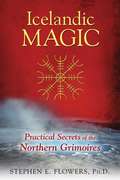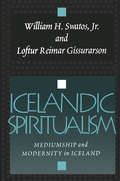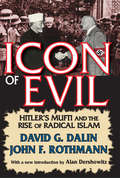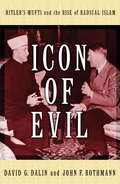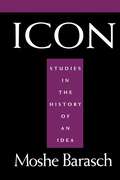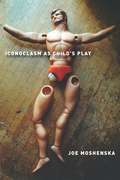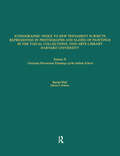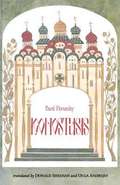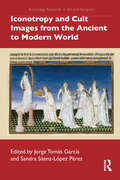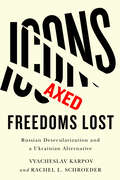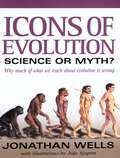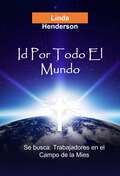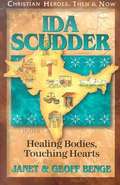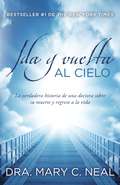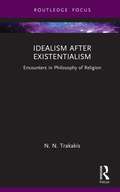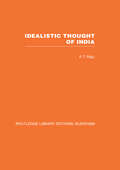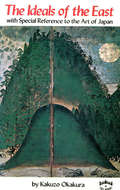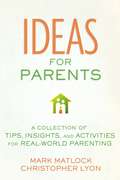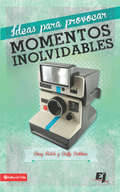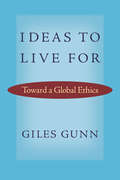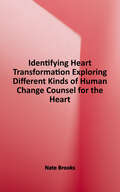- Table View
- List View
Icelandic Magic: Practical Secrets of the Northern Grimoires
by Stephen E. FlowersA practical guide to the magical systems of pre-Christian Iceland • Reveals spells and workings drawn directly from surviving magical books from the 16th to 20th century preserved at the National Library in Reykjavík • Explores the history of magic in Iceland through original translations of Icelandic folktales about famous magicians and about legendary grimoires, such as the Galdrabók, the oldest and most complete book of its kind • Explains how to personalize the spells through the creation of unique signs and symbols based on the mythic names of Odin and Icelandic magical alphabets During the Christianization of Europe in the Middle Ages, many books of magic were lost as the ancient pagan traditions were suppressed. But in Iceland the practice of recording magical spells in books continued in secret for centuries, on a scale not seen elsewhere. Now housed in the National Library in Reykjavík, these surviving grimoires, which represent only a hundredth of what was lost, reveal a rich magical tradition that continued to evolve into the 20th century. Drawing directly from the actual surviving Icelandic books of magic, Stephen Flowers presents a complete system of magic based on Icelandic lore and magical practices from the 16th century onward. He explores the history of magic in Iceland in pagan and early Christian times and reveals specific practical techniques and ritual templates that readers can adapt to their unique purposes. Illustrating traditional Icelandic magical practices and the Icelanders’ attitudes toward them, he shares original translations of Icelandic folktales about famous magicians, such as the legend of Gray-Skin, and about legendary grimoires, such as the Galdrabók, the oldest and most complete book of its kind. After initiating the reader into the grammar and symbols of Icelandic magic through history and lore, Flowers then presents an extensive catalog of actual spells and magical workings from the historical Icelandic books of magic. These examples provide ready-made forms for practical experimentation as well as an exemplary guide on how to create signs and symbols for more personalized magical work. The author also includes guidance on creating unique magical signs from the 100 mythic names of Odin, which he translates and interprets magically, and from Icelandic magical alphabets, symbols that connect Icelandic magic to the ancient runic tradition.
Icelandic Spiritualism: Mediumship and Modernity in Iceland
by Loftur Reimar GissurarsonIcelandic Spiritualism is an engaging social anthropological study of the place of spiritualism in Icelandic church and society during the first half of the twentieth century. Challenging standard theoretical approaches to the study of religion, the book contributes a wealth of data on the history of religion and psychical research, presenting it in a vivid descriptive narrative.The authors trace the role of the spirit world in Icelandic culture, giving particular attention to the distinctive history of Iceland's "conversion" to Christianity. They focus on the appearance of "modern" spiritualism as a distinct phenomenon in Icelandic life. The book studies the interaction between various groups in fin-de-siecle Icelandic society, not least in the state church, as mediumistic phenomena became widely reported through the newspapers.To some, Icelandic spiritualism may be considered a deviant case of Protestantism. What makes this book interesting, however, is that the spiritualism is seen as integral to Iceland's transition to modernity. While Icelandic Spiritualism concentrates mainly on the first half of the twentieth century, it also provides a summary of the continuation of spiritualist phenomena up to the current period. This intriguing study will be of interest to theologians, philosophers, sociologists, psychologists, and anthropologists.
Icon of Evil: Hitler's Mufti and the Rise of Radical Islam
by David DalinA chilling, fascinating, and nearly forgotten historical figure is resurrected in this riveting work that links the fascism of the last century with the terrorism of our own. Written with vigor and extraordinary access to primary sources in several languages, Icon of Evil is the definitive account of the man who, during World War II, was called "the fuhrer of the Arab world" and whose ugly legacy lives on today.With new and disturbing details, David G. Dalin and John F. Rothmann show how al -Husseini ingratiated himself with his hero, Adolf Hitler, becoming, with his blond hair and blue eyes, an "honorary Aryan" while dreaming of being installed as Nazi leader of the Middle East. Al-Husseini would later recruit more than 100,000 Muslims in Europe to fight in divisions of the Waffen- SS, and obstruct negotiations with the Allies that might have allowed four thousand Jewish children to escape to Palestine. Some believe that al-Husseini even inspired Hitler to implement the Final Solution. At war's end, al-Husseini escaped indictment at Nuremberg and was harbored in France.Icon of Evil chronicles al-Husseini's postwar relationships with such influential Islamic figures as the radical theoretician Sayyid Qutb and Saddam Hussein's powerful uncle General Khairallah Talfah and his crucial mentoring of the young Yasser Ararat. Finally, it provides compelling evidence that al-Husseini's actions and writings serve as inspirations today to the leaders of Hamas, Hezbollah, and other terrorist organizations pledged to destroy Israel and the United States.
Icon of Evil: Hitler's Mufti and the Rise of Radical Islam
by David G. Dalin John F. RothmannDalin (Hoover Institution, Stanford U. ) and Rothmann (Fromm Institute, U. of San Francisco) tell the story of Haj Amin al-Husseini, the one-time mufti of Jerusalem, and his support for the fascists during World War II. In the long-standing debate concerning whether Husseini's activities were driven by anti-Semitic hatred as opposed to anti-Zionism/Palestinian nationalism, they opt decisively for the former. Most of their discussion of Husseini's fascist activities will be relatively uncontroversial, although it's quite clear that when faced with choices of interpretation they are far more likely to chose the one that paints the mufti in a bad light, but their argument gets significantly weaker as they attempt to intimately connect Husseini to virtually every single opponent of the US and Israel in the Middle East including the Palestinian Liberation Organization, Saddam Hussein, Al-Qaeda, Hezbollah, and Hamas. Annotation ©2008 Book News, Inc. , Portland, OR (booknews. com)
Icon: Studies in the History of An Idea
by Moshe Barasch Luci SerranoOver the centuries, European debate about the nature and status of images of God and sacred figures has often upset the established order and shaken societies to their core. Out of this debate, an identifiable doctrine has emerged of the image in general and of the divine image in particular. This fascinating work concentrates on these historical arguments, from the period of Late Antiquity up to the great and classic defenses of images by St. John of Damascus and Theodore of Studion. Icon extends beyond the immediate concerns of religion, philosophy, aesthetics, history, and art, to engage them all.
Iconoclasm As Child's Play
by Joe MoshenskaWhen sacred objects were rejected during the Reformation, they were not always burned and broken but were sometimes given to children as toys. Play is typically seen as free and open, while iconoclasm, even to those who deem it necessary, is violent and disenchanting. What does it say about wider attitudes toward religious violence and children at play that these two seemingly different activities were sometimes one and the same? Drawing on a range of sixteenth-century artifacts, artworks, and texts, as well as on ancient and modern theories of iconoclasm and of play, Iconoclasm As Child's Play argues that the desire to shape and interpret the playing of children is an important cultural force. Formerly holy objects may have been handed over with an intent to debase them, but play has a tendency to create new meanings and stories that take on a life of their own. Joe Moshenska shows that this form of iconoclasm is not only a fascinating phenomenon in its own right; it has the potential to alter our understandings of the threshold between the religious and the secular, the forms and functions of play, and the nature of historical transformation and continuity.
Iconographic Index to New Testament Subjects Represented in Photographs and Slides of Paintings in the Visual Collections, Fine Arts Library, Harvard University: Christian Devotional Paintings of the Italian School
by Rachel Hall with Helene E. RobertsThis vast reference resource will appeal to anyone who wishes to find depictions of New Testament narratives from scholars, to students, to picture researchers. The first part of the book consists of a list of proper names, terms, and concepts relating to New Testament narratives represented. Under each name, term or concept, the ICONCLASS alphanumeric codes are entered, along with a brief description of the New Testament scenes in which the characters or actions occur. The second part of this text is organized according to the ICONCLASS alphanumeric codes, their order reflecting the Biblical sequence of narrative.
Iconostasis
by Pavel FlorenskyIconostasis is Fr. Pavel's final theological work. Composed in 1922, it explores in highly original terms the significance of the icon: its philosophic depth, its spiritual history, its empirical technique. In doing so, Fr. Pavel also sketches a new history of both Western religious art and the Orthodox icon: a history under the direct operation of the Holy Spirit. The work is original, challenging and profoundly articulate. This translation is the first complete English version.
Iconotropy and Cult Images from the Ancient to Modern World (Routledge Research in Art and Religion)
by Jorge Tomás GarcíaThe book examines the process of symbolic and material alteration of religious images in antiquity, the middle ages and the modern period. The process by which the form and meaning of images are modified and adapted for a new context is defined by a large number of spiritual, religious, artistic, geographical or historical circumstances. This book provides a defined theoretical framework for these symbolic and material alterations based on the concept of iconotropy; that is, the way in which images change and/or alter their meaning. Iconotropy is a key concept in religious history, particularly for periods in which religious changes, often turbulent, took place. In addition, the iconotropic process of appropriating cult images brought with it changes in the materiality of those images. Numerous accounts from antiquity, the middle ages and the modern period detail how cult images were involved in such processes of misinterpretation, both symbolically and materially. The book will be of interest to scholars working in art history, visual culture and religious history.
Iconotropy and Cult Images from the Ancient to Modern World (Routledge Research in Art and Religion)
by Jorge Tomás GarcíaThe book examines the process of symbolic and material alteration of religious images in antiquity, the middle ages and the modern period. The process by which the form and meaning of images are modified and adapted for a new context is defined by a large number of spiritual, religious, artistic, geographical or historical circumstances. This book provides a defined theoretical framework for these symbolic and material alterations based on the concept of iconotropy; that is, the way in which images change and/or alter their meaning. Iconotropy is a key concept in religious history, particularly for periods in which religious changes, often turbulent, took place. In addition, the iconotropic process of appropriating cult images brought with it changes in the materiality of those images. Numerous accounts from antiquity, the middle ages and the modern period detail how cult images were involved in such processes of misinterpretation, both symbolically and materially.The book will be of interest to scholars working in art history, visual culture and religious history.
Icons Axed, Freedoms Lost: Russian Desecularization and a Ukrainian Alternative
by Vyacheslav Karpov Rachel L. SchroederIn Icons Axed, Freedoms Lost, Vyacheslav Karpov and Rachel L. Schroeder demonstrate how Russia went from persecuting believers to jailing critics of religion and why, in contrast, religious pluralism and tolerance have solidified in Ukraine. Offering a richly documented history of cultural and political struggles that surrounded desecularization—the resurgence of religion’s societal role—from the end of the USSR to the Russo-Ukrainian war, they show Russian critics of desecularization adhered to artistic provocations, from axing icons to “punk-prayers” in cathedrals, and how Orthodox activists, in turn, responded by vandalizing controversial exhibits and calling on the state to crush “the enemies of the Church.” Putin’s solidifying tyranny heard their calls and criminalized insults to religious feelings. Meanwhile, Ukraine adhered to its pluralistic legacies. Its churches refused to engage in Russian-style culture wars, sticking instead to forgiveness and forbearance. Icons Axed, Freedoms Lost offers original theoretical and methodological perspectives on desecularization applicable far beyond the cases of Russia and Ukraine.
Icons in Time, Persons in Eternity: Orthodox Theology and the Aesthetics of the Christian Image
by C.A. TsakiridouIcons in Time, Persons in Eternity presents a critical, interdisciplinary examination of contemporary theological and philosophical studies of the Christian image and redefines this within the Orthodox tradition by exploring the ontological and aesthetic implications of Orthodox ascetic and mystical theology. It finds Modernist interest in the aesthetic peculiarity of icons significant, and essential for re-evaluating their relationship to non-representational art. Drawing on classical Greek art criticism, Byzantine ekphraseis and hymnography, and the theologies of St. Maximus the Confessor, St. Symeon the New Theologian and St. Gregory Palamas, the author argues that the ancient Greek concept of enargeia best conveys the expression of theophany and theosis in art. The qualities that define enargeia - inherent liveliness, expressive autonomy and self-subsisting form - are identified in exemplary Greek and Russian icons and considered in the context of the hesychastic theology that lies at the heart of Orthodox Christianity. An Orthodox aesthetics is thus outlined that recognizes the transcendent being of art and is open to dialogue with diverse pictorial and iconographic traditions. An examination of Ch’an (Zen) art theory and a comparison of icons with paintings by Wassily Kandinsky, Pablo Picasso, Mark Rothko and Marc Chagall, and by Japanese artists influenced by Zen Buddhism, reveal intriguing points of convergence and difference. The reader will find in these pages reasons to reconcile Modernism with the Christian image and Orthodox tradition with creative form in art.
Icons of Evolution: Science or Myth? Why Much of What We Teach About Evolution Is Wrong
by Jonathan Wells Jody F. SjogrenHow would you react if told that you and your children have been lied to in science lessons at school and university? Yet this is exactly what has been happening for decades, as Icons of Evolution' demonstrates.The author, a Berkeley Ph.D in Biology, is not a creationist, but his book describes many serious misrepresentations of facts commonly found in biology textbooks, which are used to perpetuate belief in evolution. The main part of the book describes ten of these icons', devoting one chapter to each, and shows what is wrong with them in the light of published scientific evidence. The chapters are all fairly brief, and each is divided into short sections, to make the material easier to assimilate. The author's thesis is amply documented with 71 pages of research notes at the end of the book.
Id Por Todo El Mundo: Se Buscan: Trabajadores en el Campo de la Mies
by Linda HendersonEste práctico folleto está destinado a animar a los pastores y a los laicos (o a las mujeres) por igual, de la extrema necesidad de más evangelismo. Muchos creyentes ni siquiera han oído hablar de la Gran Comisión de Mateo 28:18-20. Los cristianos no deben tener miedo de compartir su fe. ¿No quieren pasar la eternidad con su familia en el cielo? El mundo necesita escuchar la verdad, pero ¿la compartirás?
Ida Scudder: Then & Now)
by Janet Benge Geoff BengeA biography of the twentieth-century American missionary doctor to India who pioneered rural health care and the training of Indian women as doctors and nurses, and who founded Vellore Christian Medical College and Hospital.
Ida y vuelta al Cielo
by M.d. Mary C. NealUn accidente durante una aventura en Sudamérica conduce a una mujer al Cielo donde experimenta la paz, la alegría y los ángeles y de regreso a la vida. En 1999, la Dra. Mary Neal, cirujana ortopédica, esposa y madre, se ahogó durante un accidente de kayak en Chile. Al caer de una cascada, su kayak quedó atrapado en el fondo y ella quedó totalmente sumergida. A pesar de los esfuerzos de sus compañeros, Mary permaneció bajo el agua demasiado tiempo y murió. Ida y vuelta al Cielo es la extraordinaria y verdadera historia del posterior viaje espiritual de Mary y de lo que le sucedió al ir de la muerte a la vida eterna y de regreso a la vida. Al detallar sus sentimientos y su entorno en el Cielo, su comunicación con los ángeles y la profunda tristeza que sintió cuando se dio cuenta de que su momento aún no había llegado, Mary comparte con nosotros la cautivadora experiencia de este milagro. Desde entonces, la vida de Mary ha cambiado para siempre gracias a su recién descubierta comprensión de su propósito en la tierra, su conciencia de Dios, su relación más cercana con Jesús y la realización de su propio viaje espiritual. Ida y vuelta al Cielo te pondrá en contacto nuevamente con la esperanza, la maravilla y la promesa del Cielo, al tiempo que enriquecerá tu propia fe y tu recorrido junto a Dios.
Ida y vuelta al Cielo
by Mary C. NealUn accidente durante una aventura en Sudamérica conduce a una mujer al Cielo --donde experimenta la paz, la alegría y los ángeles-- y de regreso a la vida. En 1999, la Dra. Mary Neal, cirujana ortopédica, esposa y madre, se ahogó durante un accidente de kayak en Chile. Al caer de una cascada, su kayak quedó atrapado en el fondo y ella quedó totalmente sumergida. A pesar de los esfuerzos de sus compañeros, Mary permaneció bajo el agua demasiado tiempo y murió. Ida y vuelta al Cielo es la extraordinaria y verdadera historia del posterior viaje espiritual de Mary y de lo que le sucedió al ir de la muerte a la vida eterna y de regreso a la vida. Al detallar sus sentimientos y su entorno en el Cielo, su comunicación con los ángeles y la profunda tristeza que sintió cuando se dio cuenta de que su momento aún no había llegado, Mary comparte con nosotros la cautivadora experiencia de este milagro. Desde entonces, la vida de Mary ha cambiado para siempre gracias a su recién descubierta comprensión de su propósito en la tierra, su conciencia de Dios, su relación más cercana con Jesús y la realización de su propio viaje espiritual. Ida y vuelta al Cielo te pondrá en contacto nuevamente con la esperanza, la maravilla y la promesa del Cielo, al tiempo que enriquecerá tu propia fe y tu recorrido junto a Dios.
Idealism after Existentialism: Encounters in Philosophy of Religion (Routledge Focus on Philosophy)
by N. N. TrakakisA century ago the dominant philosophical outlook was not some form of materialism or naturalism, but idealism. However, this way of thinking about reality fell out of favour in the Anglo-American analytic tradition as well as the Continental schools of the twentieth century. The aim of this book is to restage and reassess the encounter between idealism and contemporary philosophy. The idealist side will be represented by the great figures of the 19th-century post-Kantian tradition in Germany, from Fichte and Schelling to Hegel, followed by the towering Hegelians in Britain led by T. H. Green, F. H. Bradley and Bernard Bosanquet. Their twentieth-century adversaries will be represented by the secular existentialists, especially the famous French trio of Sartre, Beauvoir and Camus, who sought to follow Nietzsche in philosophizing in light of the death of God. And the arena of encounter will be the philosophy of religion—more specifically, questions relating to the nature and existence of God, death and the meaning of life, and the problem of evil. The book argues that the existentialist critique of idealism enables an innovative as well as a more critical and adventurous approach that is sorely needed in philosophy of religion today. Idealism after Existentialism will be of interest to scholars and advanced students working in the history of ninteenth- and twentieth-century philosophy and philosophy of religion.
Idealism after Existentialism: Encounters in Philosophy of Religion (Routledge Focus on Philosophy)
by N. N. TrakakisA century ago the dominant philosophical outlook was not some form of materialism or naturalism, but idealism. However, this way of thinking about reality fell out of favour in the Anglo-American analytic tradition as well as the Continental schools of the twentieth century.The aim of this book is to restage and reassess the encounter between idealism and contemporary philosophy. The idealist side will be represented by the great figures of the 19th-century post-Kantian tradition in Germany, from Fichte and Schelling to Hegel, followed by the towering Hegelians in Britain led by T. H. Green, F. H. Bradley and Bernard Bosanquet. Their twentieth-century adversaries will be represented by the secular existentialists, especially the famous French trio of Sartre, Beauvoir and Camus, who sought to follow Nietzsche in philosophizing in light of the death of God. And the arena of encounter will be the philosophy of religion—more specifically, questions relating to the nature and existence of God, death and the meaning of life, and the problem of evil. The book argues that the existentialist critique of idealism enables an innovative as well as a more critical and adventurous approach that is sorely needed in philosophy of religion today.Idealism after Existentialism will be of interest to scholars and advanced students working in the history of ninteenth- and twentieth-century philosophy and philosophy of religion.
Idealistic Thought of India: Buddhism: Idealistic Thought Of India (Routledge Library Editions: Buddhism)
by P T RajuWhen first published in 1953, metaphysical idealism was still the dominant philosophy of India. This volume depicts the metaphysical strands of the life and philosophy of India in the light of those of the West and brings out the deeper implications of idealistic metaphysics.
Ideals of the East: with Special Reference to the Art of Japan
by Kazuko OkakuraHere are the long-cherished ideals of the East with special reference to the ageless art of Japan. Japan, Okakura wrote more than 60 years ago, is a museum of Asiatic civilization, and yet more than a museum, because the singular genius of the race leads it to dwell on all phases of the ideals of the past, which welcomes the new without losing the old. He wrote of that broad expanse of love for the Ultimate and Universal, which is the common thought-inheritance of Asiatic races, enabling them to produce all the great religions of the world. In Buddhism he found "that great ocean of idealism, in which merge all the river-systems of Eastern Asiatic thought-not coloured only with the pure water of the Ganges, for the Tartaric nations that joined it made their genius also tributary, bringing new symbolism, new organization, new powers of devotion, to add to the treasures of the Faith." Asiatic art and culture went hand in hand, and how well Okakura wrote about both! He describes "That constant play of colours which distinguishes the religious and artistic life of the nation, . . . now gleaming in the amber twilight of idealistic Nara, now glowing with the crimson autumn of Fujiwara, again losing itself in the green sea waves of Kamakura, or shimmering in the silver moonshine of Ashikaga-returns upon ushere in all its glory, like the fresh verdure of a rain-swept summer." In writing of the national reawakening, Okakura worried about "that portentous danger with which Western encroachments on Asiatic soil threatened our national existence." This little classic undoubtedly reflects his concern-but it also is one of the best assurances that Japan will remain true to the Asiatic soul even while it nourishes as one of the industrial giants of the world.
Ideas for Parents: A Collection of Tips, Insights, and Activities for Real-World Parenting
by Mark Matlock Christopher LyonYou know you should be more than just housemates with your kids, but as their lives become as busy as yours, that feeling of belonging together can fade. How do you maintain close bonds with your kids? What can you do if you sense that your kids are pulling away in an unhealthy manner? And what can you, as a family, actually do together that will be more meaningful than staring at screens in the same room? With practical advice on how to deepen and expand your most important human connections, Ideas for Parents will lead you in ways to develop and nourish the spiritual appetite of your family. From rebuilding the heart connection with your child to giving the gift of your attention to learning the importance of saying “I’m sorry,” here is wise counsel, quick tips, and a Christian perspective on how to deal with a host of parenting concerns.
Ideas para provocar momentos inolvidables: Para hacer hablar y pensar a los adolescentes
by Doug Fields Duffy RobbinsEn este libro encontrarás cincuenta ideas geniales para líderes de jóvenes que se atrevan a crear experiencias que impactarán de manera positiva la vida y fe de sus jóvenes. Doug Fields y Duffy Robbins escriben acerca de los hitos que marcan nuestro camino con Dios. En este libro proveen medios para crear en los jóvenes recuerdos inolvidables haciendo de esto un catálogo de ideas que puedes usar para crear en tu grupo de jóvenes momentos que parecen casi no planificados y experiencias fuera de lo común, que son particularmente intensas; recuerdos creados por llamadas telefónicas y cartas, eventos y cinta de audio, viajes y proyectos de servicio, reuniones y vigilias…y mucho más!!
Ideas to Live For: Toward a Global Ethics (Studies in Religion and Culture)
by Giles B. GunnOver the course of his distinguished interdisciplinary career, Giles Gunn has sustained his focus on the continuing threats to our collective sense of the human that seem to result from the link between the collision of fundamental values and the increase of systemic violence. He asks whether such threats can be at least mitigated, even if not removed, by understanding as opposed to force and what resources a more pragmatic cosmopolitanism might provide for doing so. How, in other words, might our sense of the human be reconstructed, not around suspicion or antipathy toward others, but around an epistemological and moral need of them? In this narrativized collection of his essays, Gunn introduces each one with a set of comments designed to explain his goal when first writing them and what they mean to him now. The variety of issues he addresses ranges from the theory of culture and cultural criticism (particularly in America), the philosophy of inter- and cross-disciplinary studies, and the psychology and politics of pragmatism to the ethics of human solidarity, the place of culture in the misshaping of international affairs, and the quest of both religion and culture for a new basis for the normative.
Identifying Heart Transformation: Exploring Different Kinds of Human Change (Counsel For The Heart)
by Nate BrooksSome people think that only Christians can experience "real change" or "lasting change." However, such observations don't hold up in real life. Confusion about change often exists because our understanding of the nature of the heart is underdeveloped. Both unbelievers and believers can change their thoughts, desires, and choices because doing so doesn't require a change of heart. Only Christians, however, can experience change at the deepest level of their humanity, as the Holy Spirit fundamentally changes them by renovating their hearts through the process of progressive sanctification. In this helpful book, Nate Brooks provides penetrating analysis and practical application.
